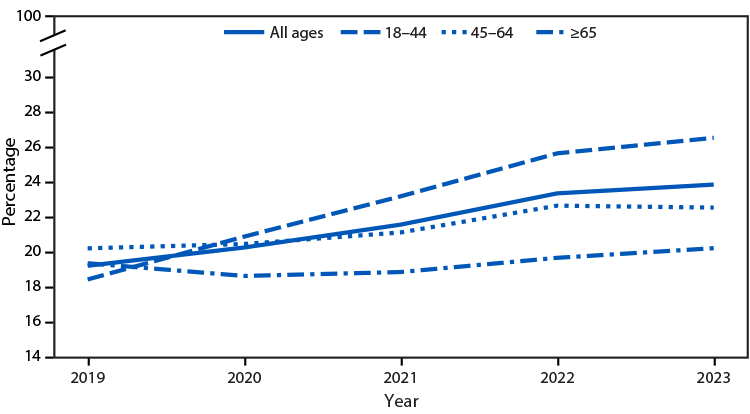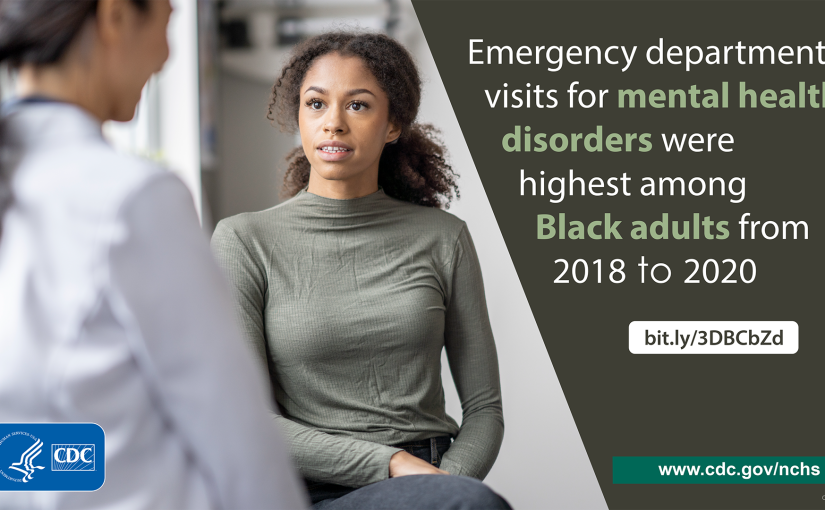Category: mental health
QuickStats: Mental Health Treatment Trends Among Adults Aged ≥18 Years, by Age Group — United States, 2019–2023

From 2019 to 2023, the percentage of adults who had received any mental health treatment during the past 12 months increased from 19.2% to 23.9%. This pattern was similar among adults aged 18–44 and 45–64 years. No significant change was observed among adults aged ≥65 years. Supplementary Table: https://stacks.cdc.gov/view/cdc/174552 Source: National Center for Health Statistics, National Health Read More >
Posted on byDiscovering Teen Health Insights with the CDC’s NHIS-Teen Survey

With the release of the new report Perceived Social and Emotional Support Among Teenagers: United States, July 2021 – December 2022 from CDC’s National Center for Health Statistics, an important finding stands out: Parents often report that their teens receive higher levels of social and emotional support compared to what the teens report. The findings Read More >
Posted on byAlmost 5% of Adults Dissatisfied with Life in 2021

According to a new National Health Statistics Report from the National Center for Health Statistics, 4.8% of adults were dissatisfied with life in 2021. The report, “Demographic Differences in Life Dissatisfaction Among Adults: United States, 2021” describes differences in life dissatisfaction by selected characteristics, grouped by family income. It uses data from the 2021 National Read More >
Posted on byNCHS Data Brief: Mental Health Treatment Among Children Aged 5–17 Years: United States, 2021

New NCHS report describes the percentage of children aged 5–17 years who have received mental health treatment in the past 12 months by selected characteristics, based on data from the 2021 National Health Interview Survey. Mental health treatment is defined as having taken medication for mental health, received counseling or therapy from a mental health Read More >
Posted on byQuickStats: Age-Adjusted Percentage of Adults Aged ≥18 Years with Serious Psychological Distress During the Past 30 Days, by Family Income — National Health Interview Survey, 2021

In 2021, 3.8% of adults aged ≥18 years had serious psychological distress during the past 30 days. The age-adjusted percentage of adults who had serious psychological distress decreased with increasing family income, from 8.9% of adults with family income <100% of FPL, to 5.8% of adults with family income 100%–199% of FPL, to 3.8% of Read More >
Posted on byQ & A from Author of Emergency Department Visits Related to Mental Health Disorders Among Adults, by Race and Hispanic Ethnicity

Q: Why did you decide to report on rates of emergency department (ED) visits for mental health disorders by race and ethnicity? ZP: As mentioned in the introduction of this report, prior research has shown that certain race/ethnicity groups are less likely to receive routine mental health care. Additionally, mental health disorders are frequently diagnosed at ED visits, Read More >
Posted on byNew Detailed Race and Ethnicity Data Query System

NCHS has released a new interactive data query system that allows users to search for data on adults about selected health topics by detailed race and ethnicity groups and subgroups in the United States. The new system provides estimates as three-year averages based on 2019-2021 final data from the National Health Interview Survey (NHIS). The three-year averages Read More >
Posted on byQuickStats: Rates of Emergency Department Visits Related to Mental Health Disorders Among Adults Aged ≥18 Years, by Disorder Category — National Hospital Ambulatory Medical Care Survey, United States, 2017–2019
During 2017–2019, 52.9 ED visits per 1,000 persons were related to a diagnosed mental health disorder (MHD) in the United States per year. Approximately one half of mental health–related visits had a diagnosis of a psychoactive substance use disorder at a rate of 27.1 visits per 1,000 persons per year, followed by an anxiety, stress-related, Read More >
Posted on byLatest Mental Health Data from Household Pulse Survey
NCHS partnered with the Census Bureau on an experimental data system called the Household Pulse Survey to monitor recent changes in mental health, telemedicine and health care access during the pandemic. The latest data collected from May 26 through June 7, 2021 shows 3 out of 10 U.S. (28.8%) reported symptoms of an anxiety or Read More >
Posted on byPODCAST: Children and Mental Health: Part Two
STATCAST, MAY 2021: DISCUSSION WITH BENJAMIN ZABLOTSKY, STATISTICIAN, ABOUT CHILDREN AND MENTAL HEALTH. https://www.cdc.gov/nchs/pressroom/podcasts/2021/20210521/20210521.htm HOST: We now continue our conversation with Ben Zablotsky, health statistician with the Division of Health Interview Statistics on children’s mental health in the United States. HOST: You mentioned social media and the Internet – what about more traditional environmental issues Read More >
Posted on byPODCAST: Children and Mental Health: Part One
STATCAST, MAY 2021: DISCUSSION WITH BENJAMIN ZABLOTSKY, STATISTICIAN, ABOUT CHILDREN AND MENTAL HEALTH. https://www.cdc.gov/nchs/pressroom/podcasts/2021/20210514/20210514.htm HOST: May is Mental Health Month in the United States. In recent years, mental health awareness has grown as a major public health issue, with suicide being one of the leading causes of death in the country. The arrival of the Read More >
Posted on byLatest Pulse Survey on Anxiety and Depression during Pandemic
The latest Household Pulse Survey shows 1 out of 3 U.S. adults (32.1%) had symptoms of an anxiety or a depressive disorder in the past week. This is the lowest percentage since the start of the survey a year ago. Also, more than half of 18-29 year olds experienced the same symptoms. More Findings: Almost Read More >
Posted on byTracking Health Care Access and Mental Health Data During Pandemic
NCHS partnered with the Census Bureau on an experimental data system called the Household Pulse Survey to monitor recent changes in monitor trends in mental health, health insurance coverage, and problems accessing care. This 20-minute online survey was designed to complement the ability of the federal statistical system to rapidly respond and provide relevant information Read More >
Posted on byQuickStats: Percentage of Children and Adolescents Aged 4–17 Years with Serious Emotional or Behavioral Difficulties by Sex and Urbanization Level
During 2016–2018, the percentage of children and adolescents aged 4–17 years with serious emotional or behavioral difficulties was higher among those living in nonmetropolitan areas (6.7%) than among those living in metropolitan areas (5.3%). Among boys, those living in nonmetropolitan areas (8.5%) were more likely to have serious emotional or behavioral difficulties than those living Read More >
Posted on by
